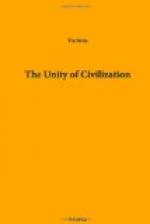South-eastward, outside the Carpathians, and within them also, in the great plain of Hungary, we meet a totally different regime; vast featureless and treeless grasslands, extending past the Black Sea and Caspian to the foot of the mountains of North Persia and the spurs of the Central Asian highlands. Here, if Man is to maintain himself at all, he must be master of tame animals which can eat the grass, and in turn sustain him. South of the eastward continuation of the woodland Mountain Zone, through Asia Minor into Persia, and also south of the Mediterranean lake-region and the ridges of Syria and the ‘Africa Minor’ of Tunis, Algeria, and Morocco, which partly enclose it, lies another group of grasslands, Arabia and Sahara, desert-hearted, but capable of sustaining a considerable population of nomad pastoral folk round their margins and in oases, and of emitting them in volcanic emigrations now and then.
From the human point of view, the profound difference between the northern and the southern group of these grasslands, which collectively lie athwart the great east-and-west mountain zone of the Old World, is this. The southern grassland sustains sheep and goats almost exclusively; it acquired its domesticated horses recently (at earliest about 2000 B.C.) and from the north-east; and it relies, for transport, on camels and asses, not on wheeled vehicles. The northern, on the other hand, has sufficient perennial pasture to permit of oxen; it uses horses habitually; and it has utilized the timber of its parkland margin, where it passes over into the northern forest, to construct wheeled carts and ox-ploughs. Equipped with these fundamental implements of civilization, wheel-borne nomads have penetrated the Mountain Zone from the north again and again, introducing the cart into Egypt rather late, and perhaps even into Babylonia; though with these exceptions no secondary centre of cart-folk was ever established in the south. Obvious reasons for this failure lie in the scarcity of parkland and of perennial pasture for large cattle. At best, Assyria and Syria adopted the horsed chariot for war; but these regions, like the Hittite chariot-users of Asia Minor, the Achaean conquerors of the Greek peninsula, and the Gauls in West-Central Europe, are rather within the parkland fringes of the Mountain Zone, and among those intermont plateaux which we have noted already, than borderers of the Grassland itself. In particular, they are all sedentary, and stand in this respect contrasted with the migratory Scythian cart-folk in the northern Grassland. The only nomad cart-folk within the Mountain Zone are the Gipsies,[11] and they seem mainly to have formed their habit of life in the largest intermont plateau of all, the vast table-land of Persia.




